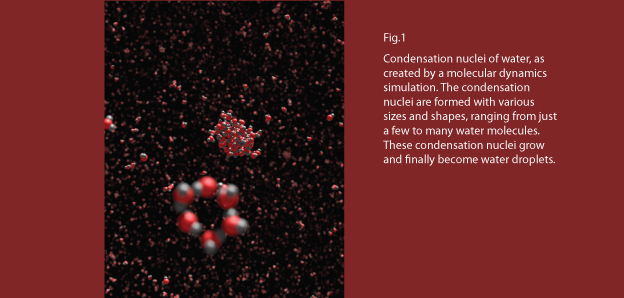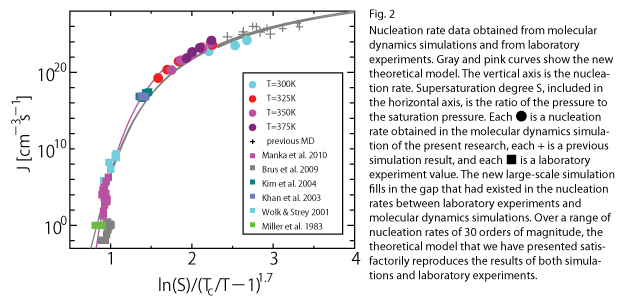Large-Scale Molecular Dynamics Simulation of Water Nucleation —Success in Reproducing Laboratory Low Nucleation Rates
Research Press Release | September 07, 2015
-
 Condensation nuclei of water, as created by a molecular dynamics simulation.
Condensation nuclei of water, as created by a molecular dynamics simulation. -
 Nucleation rate data
Nucleation rate data
| Press Release | ||
|---|---|---|
| Key Points | ・Homogeneous nucleation from water vapor was reproduced using a large-scale molecular dynamics simulation. For the first time in the world, a molecular dynamics simulation has been used to reproduce water nucleation to achieve low nucleation rates achieved in laboratory experiments.
・A new theoretical model that satisfactorily reproduces all the data on water vapor nucleation rates obtained from molecular dynamics simulations and from previous laboratory experiments is proposed. This data extends over 30 orders of magnitude. |
|
| Overview |
Nucleation, in which liquid droplets form from saturated vapor, is an important research subject that spans a wide range of science and engineering fields, including meteorology (formation of cloud particles) and engineering (formation of nanoparticles). However, condensation nuclei that initially form are the extremely small size of nanoparticles, so it is difficult to predict their rate of formation with good accuracy, and there still is no effective, general theory. An international joint research team from Hokkaido University and the University of Zurich used a supercomputer to perform large-scale molecular dynamics simulations of up to 12,000,000 atoms, and clarified the process of homogeneous nucleation from water vapor. They were successful in reproducing phenomena that progress at a low nucleation rate that is only 1/100,000 of previous calculations, and reach the same nucleation rate as obtained in laboratory experiments. The data obtained for nucleation rates from water vapor at various temperatures and pressures, and the data obtained from laboratory experiments, range widely over 30 orders of magnitude, and allows us to present a new theoretical model that satisfactorily reproduces all this data. [Terms] Molecular Dynamics Simulation: A method of performing computer simulations of the individual motions of atoms and molecules in order to elucidate the properties of microscopic substances. Compared to laboratory experiments, this method makes it easier to obtain complete information about the positions and motions of atoms. |
|
| Inquiries |
Kyoko TANAKA, Japan Society for the Promotion of Science (JSPS)Fellow, Institute of Low Temperature Science, Hokkaido University TEL: +81-11-706-5486 FAX: +81-11-706-7142 E-mail:kktanaka@lowtem.hokudai.ac.jp Hidekazu TANAKA, Assoc. Prof., Institute of Low Temperature Science, Hokkaido University TEL: +81-11-706-5472 FAX: +81-11-706-7142 E-mail: hide@lowtem.hokudai.ac.jp |
|
|
Japanese Link |
水の凝縮核生成の大規模分子動力学シミュレーション ~室内実験レベルの低生成率での凝縮核生成の再現に成功~ (2015.8.19) | |
| Publications | Homogeneous SPC/E water nucleation in large molecular dynamics simulations, Journal of Chemical Sciences (2015.8.11) | |
